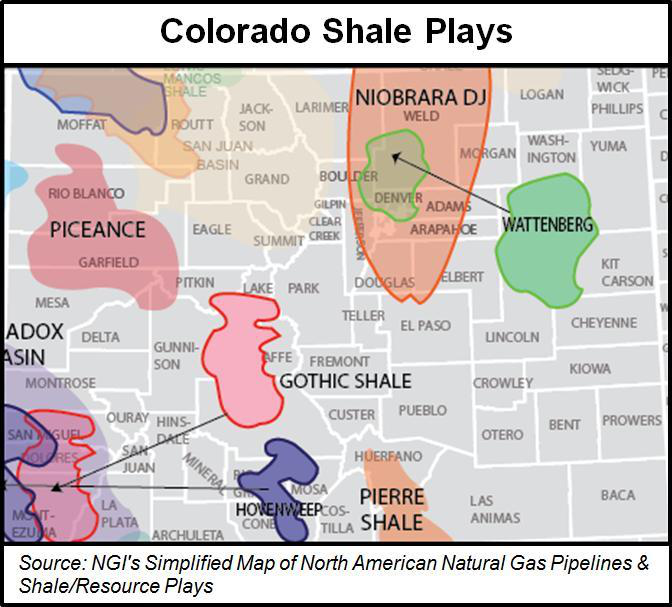Niobrara Operators Tested by Colorado Floods
Although the storms are gone, the troubles from historic flooding along the Front Range in Colorado continued to pop up Thursday in the Niobrara Formation portion of the Denver-Julesburg (DJ) Basin. Anadarko Petroleum Corp. wrestled with oil spills from two of its tank batteries damaged by the still-raging flood waters.

State officials said their major concern in the storms’ aftermath is centered on crude oil stored in tanks at various well sites, along with addressing the general public concern about chemicals used in hydraulic fracturing, which also can be stored at some well sites. What industry sources labeled as “significant debris” causes the tanks and flow-lines used to transfer oil between equipment at the two well sites to shift.
According to reports Anadarko made to the Colorado Oil/Gas Conservation Commission (COGCC) and reported by the Colorado Oil and Gas Association (COGA), 125 barrels (5,250 gallons) of light-oil releases occurred Wednesday, spilling into parts of the South Platte and St. Vrain Rivers.
COGCC and Anadarko emphasized that the spills were being “remediated,” but offered no details on what was being done to clean up and stop any additional spillage.
In its public response Wednesday, COGCC said it understood “public concerns about [fracking] chemicals,” but generally those chemicals are only on site during drilling and fracturing operations. “They do not remain onsite once the well is in production,” said COGCC, adding that “the vast majority of wells impacted were in the producing stage.
“Operators in the flood-affected areas were aggressive about shutting in wells — stopping the production of oil and gas — before the flooding began or very early in the event. The majority of the well sites are on automated systems that allow operators to remotely shut in the wells,” COGCC reiterated.
COGA underscored that facts on fracking fluids, noting in its report Thursday that “there was no release of chemicals or fracturing fluid additives…these chemicals are not stored at production facilities.”
COGA said major operators in the area reported at the beginning of this week that 1,976 wells were shut in. “Today (Thursday) that number has dipped to 1,679, and 297 wells are back in production.”
Through aerial surveys and reports from the hundreds of field personnel deployed by operators to evaluate the facilities following the brunt of the storms, COGCC said it confirmed that floodwater or debris have “caused tanks to shift in place or move off a pad at some well sites. Most locations observed to this point [end of Wednesday] have found tank and well pads to be intact and in place, but teams are still early in their assessment work.”
Separately, Encana Corp., which operates more than 1,200 wells in the DJ Basin, reported an additional 65 of its shut-in wells had been brought back to service as of Thursday morning, leaving 180 wells still shut in, a Denver-based spokesperson told NGI‘s Shale Daily. “As of last night, no reportable hydrocarbon spills were found,” the spokesperson said.
Noting that the vast majority of the wells are natural gas although some are oil, Encana’s spokesperson said that a six-person environmental assessment team will complete inspections of all of the company’s facilities in the Niobrara portion of the DJ Basin by the end of the day Thursday.
While most of these Encana assets are gas related, an unknown number are horizontally drilled oil wells, the spokesperson said.
Like Encana, Anadarko has had a number of wells impacted by the record flooding. Of the company’s roughly 5,800 operated wells in the area, approximately 1,000 wells were shut in at one point, and 650 wells were still out of service as of the start of the day Thursday.
Anadarko on Wednesday reported the spillage into the Platte and St. Vrain Rivers to COGCC, the National Response Center [for oil spills], the U.S. Environmental Protection Agency, and the Colorado Department of Public Health and Environment.
“We are actively working under the oversight of these agencies to contain and clean up the releases to the greatest extent possible,” an Anadarko said in a website-based status report on the Colorado flooding.
COGCC said it will continue its assessment of oil/gas facilities that are in the path of the flooding. The state oversight agency said it has deployed four inspection teams, including engineering and environmental protection specialists.
The operators continued to have no estimates on the volumes of gas impacted by the continuing shut ins, but earlier, third-party estimates placed the curtailed volumes at 600-800 MMcf as of Tuesday.
© 2024 Natural Gas Intelligence. All rights reserved.
ISSN © 2577-9877 | ISSN © 2158-8023 |

